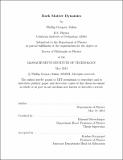| dc.contributor.advisor | Edmund Bertschinger. | en_US |
| dc.contributor.author | Zukin, Phillip Gregory | en_US |
| dc.contributor.other | Massachusetts Institute of Technology. Dept. of Physics. | en_US |
| dc.date.accessioned | 2013-03-01T14:34:08Z | |
| dc.date.available | 2013-03-01T14:34:08Z | |
| dc.date.copyright | 2012 | en_US |
| dc.date.issued | 2012 | en_US |
| dc.identifier.uri | http://hdl.handle.net/1721.1/77258 | |
| dc.description | Thesis (Ph. D.)--Massachusetts Institute of Technology, Dept. of Physics, 2012. | en_US |
| dc.description | This electronic version was submitted by the student author. The certified thesis is available in the Institute Archives and Special Collections. | en_US |
| dc.description | Cataloged from student-submitted PDF version of thesis. | en_US |
| dc.description | Includes bibliographical references (p. 147-150). | en_US |
| dc.description.abstract | N-body simulations have revealed a wealth of information about dark matter halos but their results are largely empirical. Here we attempt to shed light on simulation results by using a combination of analytic and numerical methods. First we generalize an analytic model of halo formation, known as Secondary Infall, to include the effects of tidal torque. Given this model we compare its predictions for halo profiles to simulation results and infer that angular momentum plays an important role in setting the structure of dark matter profiles at small radii. Next, we focus on explaining the origin of universality in halos. We find evidence that diffusion -- which can potentially lead to universality -- occurs during halo evolution and is partially sourced by external torques from large scale structure. This is surprising given that the halo is nonlinear and typically thought to be unaffected by neighboring structures. Last, we describe promising ways to analytically describe the evolution of nonlinear halos using a Fokker-Planck formalism. | en_US |
| dc.description.statementofresponsibility | by Phillip Gregory Zukin. | en_US |
| dc.format.extent | 150 p. | en_US |
| dc.language.iso | eng | en_US |
| dc.publisher | Massachusetts Institute of Technology | en_US |
| dc.rights | M.I.T. theses are protected by
copyright. They may be viewed from this source for any purpose, but
reproduction or distribution in any format is prohibited without written
permission. See provided URL for inquiries about permission. | en_US |
| dc.rights.uri | http://dspace.mit.edu/handle/1721.1/7582 | en_US |
| dc.subject | Physics. | en_US |
| dc.title | Dark matter dynamics | en_US |
| dc.type | Thesis | en_US |
| dc.description.degree | Ph.D. | en_US |
| dc.contributor.department | Massachusetts Institute of Technology. Department of Physics | |
| dc.identifier.oclc | 827730707 | en_US |
